Sydney Royal Easter Show
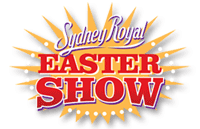
The Sydney Royal Easter Show, also known as the Royal Easter Show or simply The Show or (to exhibitors) The Royal, is an annual show held in Sydney, Australia over two weeks around Easter. It is run by the Royal Agricultural Society of New South Wales and was first held in 1823. Queen Victoria, (1837–1901), awarded the society and its show the right to use the word "Royal" in its name.[1] The Show is historically an event where "city meets country" and the rural industries of Australia can be shown and celebrated once a year.[2]
The Show comprises an agricultural show, an amusement park and a fair and combines the elements of each, showcasing the judging of livestock and produce. This comprehensive fair has many competitions including arts and crafts, photography and cookery, as well as tests of strength and skill such as wood chopping. The Show also has shopping, restaurants, commercial stands and exhibits, a horticultural display, a national accredited conformation dog show and cat show, and stage and arena shows. The Show currently attracts more than one million people per year.
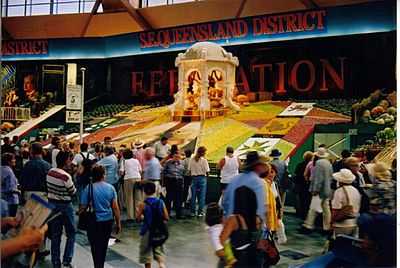
History

The Sydney Royal Easter Show is the largest event held in Australia, and the sixth largest in the world. The first Easter Show was held in 1823 by the newly formed Agricultural Society of New South Wales, with the aim of encouraging the colony's rural industries. The site was at Parramatta, 24 kilometres west of the town of Sydney, and the display included horses, cattle, sheep, pigs and poultry.
In 1869, the venue was moved from Parramatta to Prince Alfred Park until 1881 when the Government of New South Wales provided land for the Royal Agricultural Society at Moore Park where the show was held for 116 years. In 1998, the Show moved to a new showground in Sydney Olympic Park at Homebush Bay. The former Sydney Showground at Moore Park has since been converted into Fox Studios Australia with associated development known as The Entertainment Quarter.[3]
The Show has been held every year since 1869 except during the severe outbreak of the Spanish flu in 1919 and between the years of 1942 and 1946 when it was interrupted by World War II.[4] Traditionally, the Show began on the Friday before Easter, was closed on Sundays and Good Friday and packed up the Tuesday following Easter, the Tuesday being "Children's Day" when goods such as showbags were reduced in price.

At the RAS Showground at Moore Park, the largest single event of the Show was the Grand Parade on Easter Saturday when hundreds of beasts representing the various classes of livestock were paraded in a series of concentric circles. To the public eye, this spectacular sight, which involved creatures ranging from newborn lambs and Shetland ponies to Brahman bulls and Clydesdale stallions, was staged with such skill that it invariably took place without a hitch. However, on one memorable occasion a steer broke loose and plunged into the quarters of the Royal Agricultural Society. The Grand Parade continues to take place, though on a somewhat smaller scale, at the Sydney Stadium venue.
Yielding to pressure from the public, the Show was later to be opened on Sundays and Good Friday. With the move to Homebush Bay, the Show was extended to two weeks. In 2007, a revised program took into account changes to NSW School Holidays, the Show commencing on the Thursday before Good Friday in order to increase the holiday time for families to attend.[5]
Overview
Rural industry
Horticulture
The first purpose of the Show is specifically to encourage agriculture. Although other aspects of the show have developed including competitions, entertainment and commerce, the display of the products of rural industry remain of major importance, the RAS claiming 30,000 rural exhibits in 2007.[6] One of the most popular sights at the show is the "District Exhibits" competition. These displays are set up by four districts of NSW and South East Queensland. A theme is selected and created pictorially on a large scale, to strict rules and using only the produce of the particular district which typically includes wool, wheat, apples, pumpkins, sugar cane, citrus fruit, vegetables and brightly coloured bottles of preserves. Also displayed are other primary products such as fleeces, carcases of beef, wine, honey, cheese and sausages. There is also a flower show at which are judged both horticultural specimens and floral displays.

Livestock
During the course of the show, a large range of livestock is judged. This includes the famous Merino sheep, whose fine wool was a major source of Australia's wealth in the 19th and 20th centuries. Also shown are dairy cattle of which the major breeds are the Australian Illawarra Shorthorn, Friesian, Ayrshire, Jersey and Guernsey. Beef cattle are predominantly Hereford, Aberdeen Angus and Murray Grey with other breeds including Brahman, Devon and Charolais. Other livestock judged at the show include a variety of sheep, pigs, goats, alpacas and poultry of all sorts.
Horses
The central arena of the showground is used throughout the show for the judging more than 1,000 equestrian events. The classes include events for horses, riders, pairs, teams, rodeo riders, show jumping and driving. Horses are shown in 24 different breed classes including Australian Stock Horses, Buckskins, Clydesdales, Hackneys, Miniature Horses, Australian National Saddlehorses, Palominos, Percherons, Pintos, Shetland Ponies, Shires, and Warmbloods etc. A large section of the ridden classes are pony, galloway and hack height classes, and the "Sydney Royal" is considered one of the hardest and most prestigious shows in Australia. A popular sight in the arena is the Carlton & United Brewery wagon, drawn by the team of "Carlton Clydesdales".
Domestic animals
As part of the Royal Easter Show there is a Dog Show in which about 3,000 dogs are displayed and judged. There is also a Cat Show and competitions for caged birds, rabbits, mice and rats. There is a large pigeon show. Displays are given by working dogs, Australian Kelpies, Border Collies and Australian Cattle Dogs.
Animal Nursery
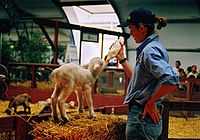
One of the most popular exhibitions of the Show is the Animal Nursery. In this large purpose-built shed a great variety of common and uncommon domestic animals are put on display, in a way that is highly accessibly to families with young children. Animals are shown with their young. Children are allowed to pat most of the animals and areas are reserved where children can enter the enclosures with explainers and get closer to small animals such as rabbits, lambs and ducks. Popular features are the chick hatchery and the duckling water slide.
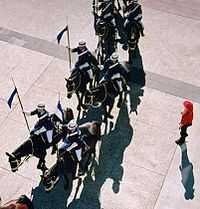
Rural competitions
"The Woodchop" is one of the most popular demonstrations and competitions, taking place in a purpose-built stadium. The timber used is Australian hardwood so the splinters really fly.
Other popular events are the Tent Pegging and the Polocrosse with the NSW Mounted Police on their well-matched bay horses always competing. The Dressage and Show Jumping are the culmination of Australia-wide gymkhanas held at the annual circuit of local agricultural shows, with successful competitors going on to Olympic competition. The equally demanding but less fastidious skills of buckjumping and steer-roping draw young men from across Australia and Northern America to compete in the Rodeo.
Arts and Crafts
Since the 19th century competitions have been held "for the ladies". These competitions have traditionally included the making of scones, fruitcake and preserves. Crafts have traditionally included three crochetted doilies, a smocked baby's dress and a man's knitted sleeveless sweater. Over 100 years the classes have been expanded to include a vast range of cooking and crafts in which men may also compete. Among the crafts are the spinning, weaving and dyeing of wool, woodwork, leatherwork, enamelling, lacemaking, embroidery, toymaking and patchwork.
The various fashions in craft have changed dramatically over the years and these changes are reflected in the number of exhibits and in the classes. From 1960 until about 1990 one of the most popular crafts was cake decorating, with numerous expert decorators vying for fineness in their "extension work" and creating designs of extraordinary delicacy and intricacy. In the 21st century these technical skills have almost disappeared. On the other hand, the art of paper tole, also requiring of much fine control, has become a popular craft, as witnessed by the large number of entries to the competition.
Associated with the Show, and displayed in the same pavilion as the craft competitions is an Art Show with classes for Rural subjects, Still Life, Watercolour and Figurative painting. There are competitions for sculpture, photography, silverwork and ceramics.
Other contributors
Government displays
The State and Federal Governments both contribute exhibitions to the show though their presence has diminished significantly since the relocation to Homebush Bay in 1998. Many government departments such as NSW Lotteries, Cityrail and NSW Health have axed their annual displays. However bodies such as The Rural Fire Service, the NSW Police, the Ambulance Service, the Army Reserve continue to set up displays to inform and promote goodwill to the public.
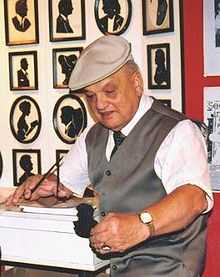
Services
Foremost among the charitable bodies and service organisations with an active presence at the Show are the St. John Ambulance Australia who not only provided on the spot attention for sunstroke but also injuries sustained while steer-roping. Providing sustenance of another sort is the Country Women's Association or CWA who have a prominently placed cafe selling Devonshire Teas and other goodies.
Commercial
An important tradition of the Royal Easter Show since 1900 is the selling of merchandises known as showbags.[4] Originally called 'Sample Bags' (and free),[4] they were a means for manufacturers to market their products to the general public, today showbags often come in the form of promotional merchandises, as well as toys targeting children.
Apart from Showbag Hall there are many other commercial enterprises who are "stall holders" at the Royal Easter Show. These range from international companies providing finance and agricultural plant to purveyors of fairground ephemera, fairy floss and meat pies. Many of the manufacturers represented are providing goods closely associated with rural industry such as work boots, woollen sweaters and the iconic Akubra hat and Driza-Bone raincoat. S. John Ross, master of the silhouette, (pictured right) won the Legend Award at the 2007 Royal Easter Show. S. John Ross worked until his death at age 89.
Entertainment
The Royal Easter Show has a sideshow alley along which are the amusement rides, sideshows and competitive stands. The provided entertainment includes pop music concerts and, in 2007, a staged sideshow program has been introduced as well.
In 2009, the show debuted three new amusement rides, Pirate's Revenge(a Reverchon Log Flume), Buried Alive (a motion simulator simulating being buried alive) and the Haunted Hotel (Ghost Train). These join such traditional delights as Frank Laurie's Steam Merry-Go-Round, built in the 1890s and touring Australia for 80 years.
In the evening the NAB Arena becomes the venue for spectacular entertainment which regularly includes the NSW Mounted Police Musical Ride, the Precision Driving display, originally performed in Holdens, but in recent years Toyotas . The entertainment culminates with fireworks. The Australia versus New Zealand Rodeo Teams Challenge is also an exciting event with plenty of action.
Pricing
The Show organisers received public criticism for the pricing of the 2006 show.[7] The cost was approximately A$30 per adult and A$20 per child for entry, but including food and souvenirs the estimated cost per person ran to A$80. It was widely expressed that the Show was out of reach of low income earners and poor families.
The 2007, pricing was even higher than 2006, with adults at A$31.00, with a discount of 10% ($27.90) if purchased online, children's tickets were A$21.50 or $19.30 with an online purchase, and concessions are $25.50 or $22.90 when bought online.[8] The tickets in 2008 were $32 for adults, 25.50 for concessions. There was a "kids' day" on the last day with admission for children at $10.The 2013 prices are $37.50 for an adult, $23.50 for children and $28.00 for concessions.
Tickets for the Show can be purchased on line via ticketmaster and from Woolworths Supermarkets where the pass includes travel. Tickets were previously available at Railway Stations and on some buses however as of 2015 this option has been discontinued. In 2015 Showbags have been priced from $1.00 to $30.00
Photo gallery
-
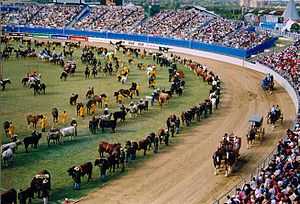
The Grand Parade at Olympic Park.
-

The Grand Parade pauses for photographs.
-

The Western District display.
-

The Precision Driving Team performs in the main arena.
-

Sideshows and rides are a popular part of the Show.
-
The first place winner in the "Ridden Hack" class is escorted on a lap of honour by a steward.
-
Hacks of 16 hands and over.
-

The Merino ram, icon of Australia's rural industry.
-
The Champion Superfine Merino fleece
-
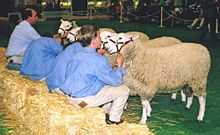
Border Leicesters lined up for the judge.
-

A goose.
-
A Nubian goat.
-
A Wessex Saddleback pig.
References
- ↑ "Historical Summary". The Royal Agricultural Society of NSW. Retrieved 19 February 2007.
- ↑ "About the Royal Agricultural Society of NSW". Sydney Royal Easter Show. 10 March 2007. Archived from the original on 27 February 2007. Retrieved 10 March 2007.
- ↑ "Overview of the Show". Sydney Royal Easter Show. 10 March 2007. Archived from the original on 7 March 2007. Retrieved 10 March 2007.
- ↑ 4.0 4.1 4.2 "Royal Agricultural Society of New South Wales-History Timeline ", rasnsw.com, Retrieved 29 March 2010
- ↑ "About the Royal Agricultural Society of NSW". Sydney Royal Easter Show. 10 March 2007. Archived from the original on 27 February 2007. Retrieved 10 March 2007.
- ↑ "Sydney Royal Easter Show". Retrieved 9 April 2007.
- ↑ Welch, Dylan (20 April 2006). "Show boss 'damn sorry' about prices". The Sydney Morning Herald. Retrieved 24 November 2006.
- ↑ "Overview of the Show". Sydney Royal Easter Show. 10 March 2007. Archived from the original on 8 March 2007. Retrieved 10 March 2007.
External links
| Wikimedia Commons has media related to Sydney Royal Easter Show. |




